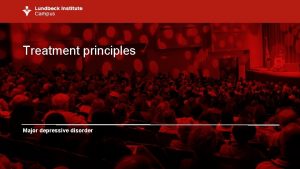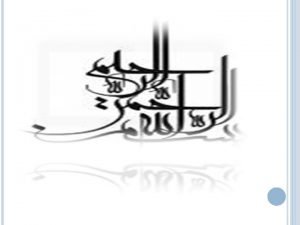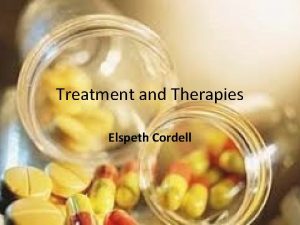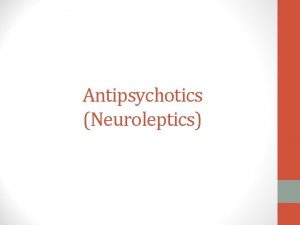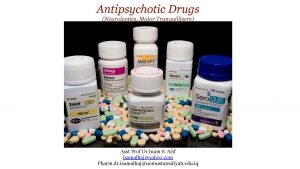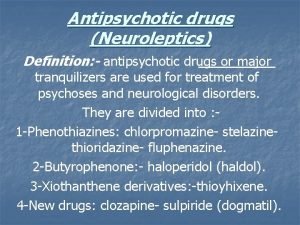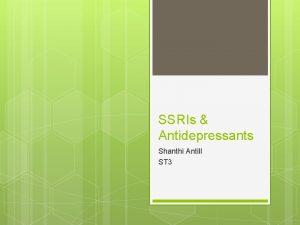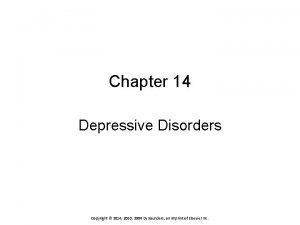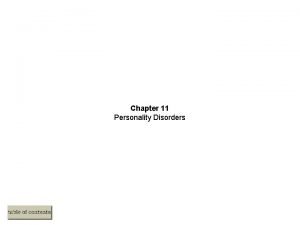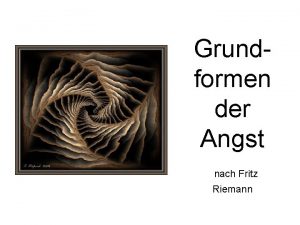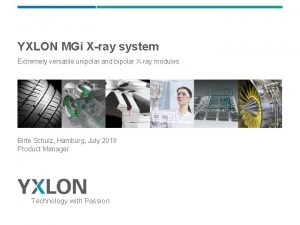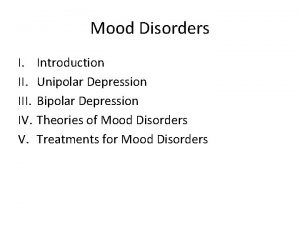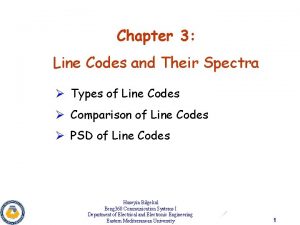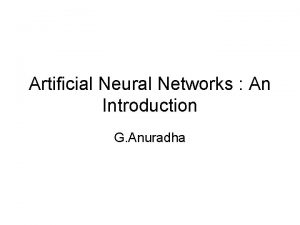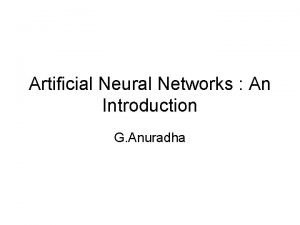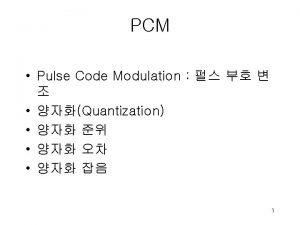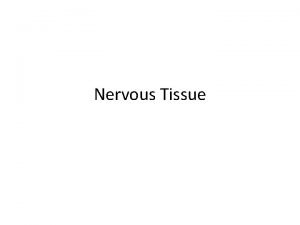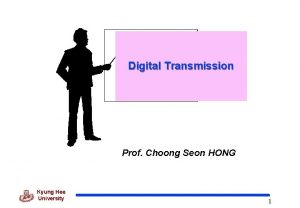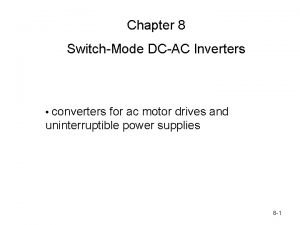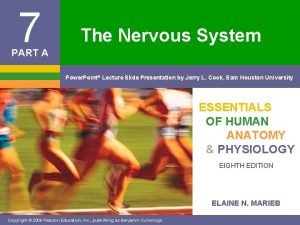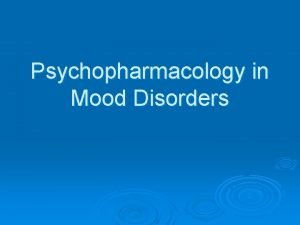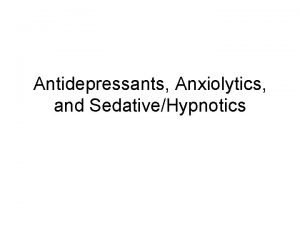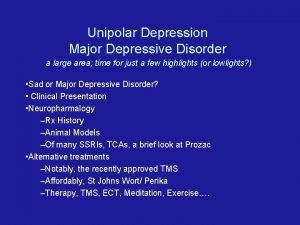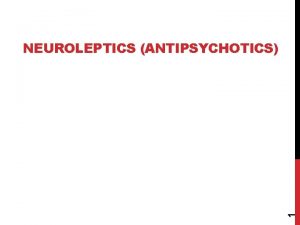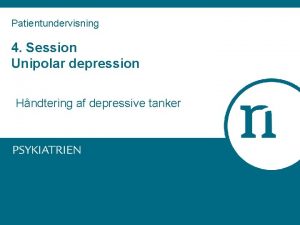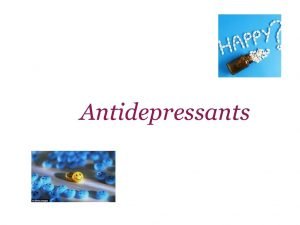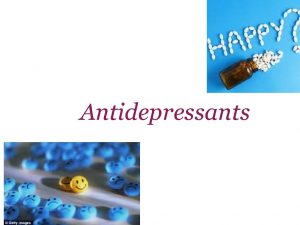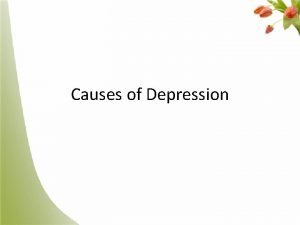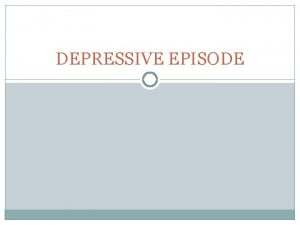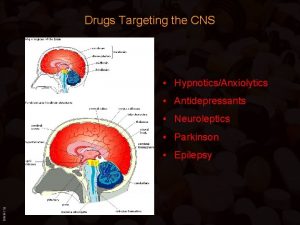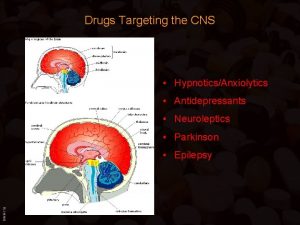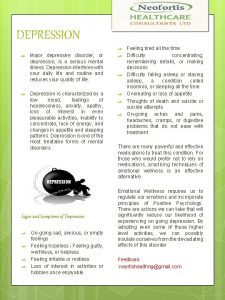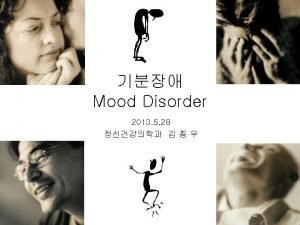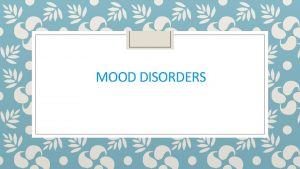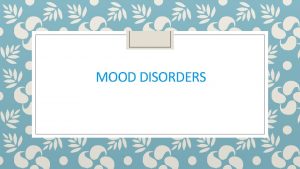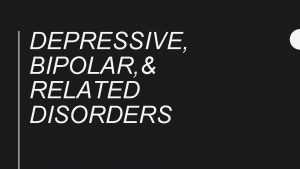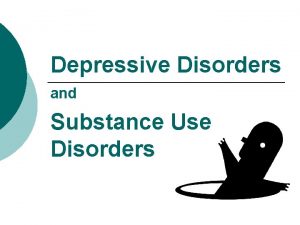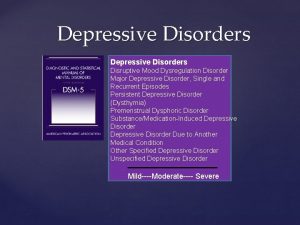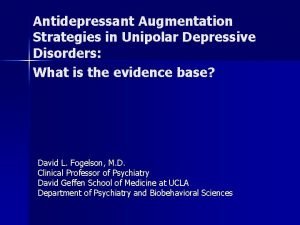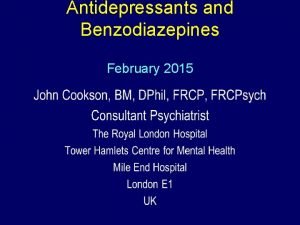Antidepressants Neuroleptics Lesson 20 Unipolar Depression Major Depressive





















- Slides: 21

Antidepressants & Neuroleptics Lesson 20

Unipolar Depression Major Depressive Disorder n Extreme sadness & despair l extent & duration important n Prevalence n ufemales 9 -26% umales 5 -12% l 2: 1 females ~

MAOIs n Monoamine oxidase inhibitors utranylcypromine (Parnate), phenelzine, (Nardil) NE, DA, 5 -HT n Dietary restrictions (Cheese Effect) l avoid foods containing tyramine l metabolism amphetamine-like l urisk of cerebral hemorrhages Many drug interactions n Overdose risk ~ n

Nonselective Cyclic Antidepressants n Reuptake inhibitors l DA, NE, & 5 HT l Tricyclic Antidepressants (TCA) u. Imipramine, l Desipramine Tetracyclic u. Maprotiline n Risk of many drug interactions (e. g. , alcohol, neuroleptics, etc. ~

NSCA: Main Side Effects Risk of overdose n Mania or psychosis n Sedation n Anticholinergic syndrome l tremors, dry mouth, weakness, constipation, blurred vision, confusion n Impotence n

Second Generation Antidepressants

SSRIs Selective serotonin reuptake inhibitors l fluoxetine (Prozac, Sarafem) l sertraline (Zoloft) l paroxetine (Paxil) l citalopram (Celexa) l escitalopram (Lexapro) l fluvoxamine (Luvox) n Fewer fx on NE & DA ~ n

SSRIs: Side Effects Fewer than TCAs l lower sympathetic arousal l no anticholinergic fx n Serotonergic syndrome l GI discomfort, anxiety, restlessness, insomnia, etc. n Sexual dysfunction n Low risk of overdose n Equally effective as TCAs ~ n

SSRIs: Pharmokinetics All similar to fluoxetine (prozac) l lipid soluble l high protein binding n Half-life l 2 - 3 days l active metabolite 7 - 15 days n unorfluoxetine ~

Other Selective Reuptake Inhibitors Norepinephrine Dopamine Reuptake Inhibitor (NDRI) l bupropion (Welbutrin) l Also tx bipolar & Smoking cessation (Zyban) n Side fx l less sexual dysfuntion than SSRI l Insomnia l seizures - 150 mg/dose limit l no subjective euphoria, abuse ~ n

Other Selective Reuptake Inhibitors Selective Serotonin Norepinephrine Reuptake Inhibitor (SNRI) l venlafaxine (Effexor) n Serotonin-2 Antagonists/Reuptake Inhibitors (SARI) l 5 HT 2 –R: autoreceptor l Anxiety disorders, bulimia n Noradrenergic/Specific Serotonergic Antidepressant (Na. SSA) l Mirtazapine (Remeron)~ n

Schizophrenia Disordered thoughts & bizarre behavior l 1 percent of population l equal among sexes n Progressive l can only manage symptoms ~ n

Symptoms Positive Symptoms l Thought disorders l Delusions l Hallucinations n Negative Symptoms l Poverty of speech l Poverty of emotion l Social withdrawal ~ n

Neuroleptic Drugs Also called antipsychotics n All Effective l No abuse liability l Low overdose liability n Major side Effects: l Motor impairments l Agranulocytosis ~ n

Patient Populations: Mental Institutions 600 1956 500 400 Thousands of patients 300 200 1900 1930 1960 YEAR 1975

First Generation Neuroleptics Relieve only positive symptoms n Chlorpromazine (Thorazine) l phenothiazines l primarily blocks D 1 & D 2 n Haloperidol (Haldol) l butyrophenones l primarily blocks D 2 n D 2 -R affinity and clinical potency ~ n

Hi Therapeutic effects Lo Spiroperidol Haloperidol Chlorpromazine Strength of D 2 binding

1 st Generation: Pharmacokinetics Administration l Primarily p. o. ; im for rapid effects n 90 -95% depot binding l liver, lungs, adrenals, spleen n Long half-life l Some metabolites active up to 3 mo. n u. No symptoms during this period ucompliance problems ~

Major Side Effects Movement Effects (Extrapyramidal) l Parkinsonism l Akathisia l Tardive Dyskinesia n Agranulocytosis l white blood cells (WBC) l Not frequent, but 50% mortality ~ n

Atypical Neuroleptics n n n Relieve negative & positive symptoms Lower M-PAT risk l tardive dyskinesia Atypical neuroleptics l affinity for D 2 -R l 5 HT antagonism ~

Atypical Neuroleptics Clozapine Clozaril l Agranulocytosis n Risperidone Risperdal l agranulocytosis; M-PAT n Aripiprazole (Abilify) l depression ~ n
 What's bipolar
What's bipolar Major depressive disorder
Major depressive disorder Tricyclic antidepressants overdose
Tricyclic antidepressants overdose Antidepressants meds list
Antidepressants meds list Neuroleptics
Neuroleptics Clozapen
Clozapen Neuroleptic drug
Neuroleptic drug Switching antidepressants chart
Switching antidepressants chart Chapter 14 depressive disorders
Chapter 14 depressive disorders Mnemonic for antisocial personality disorder
Mnemonic for antisocial personality disorder Fritz riemann grundformen der angst
Fritz riemann grundformen der angst Unipolar generator
Unipolar generator Unipolar disorder
Unipolar disorder The psd of a line code depends on
The psd of a line code depends on Step activation function
Step activation function Unipolar continuous activation function
Unipolar continuous activation function Puls0
Puls0 Unipolar neurons are found in
Unipolar neurons are found in Unipolar
Unipolar Dcac converters
Dcac converters Unipolar neurons are found in
Unipolar neurons are found in Hbs 2+2
Hbs 2+2

